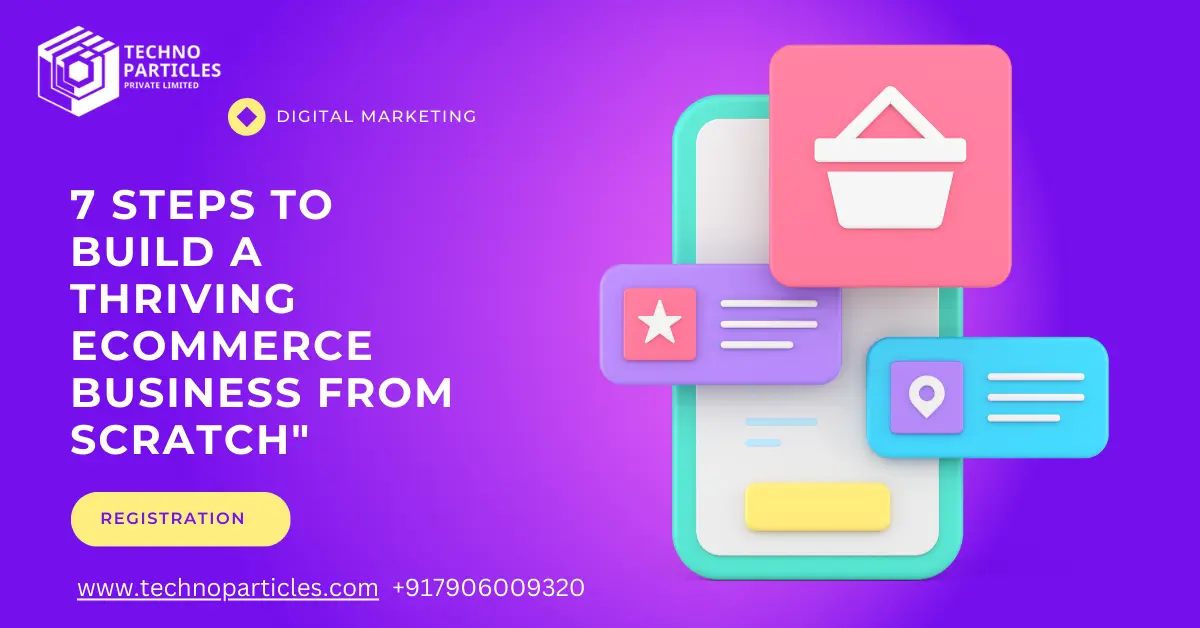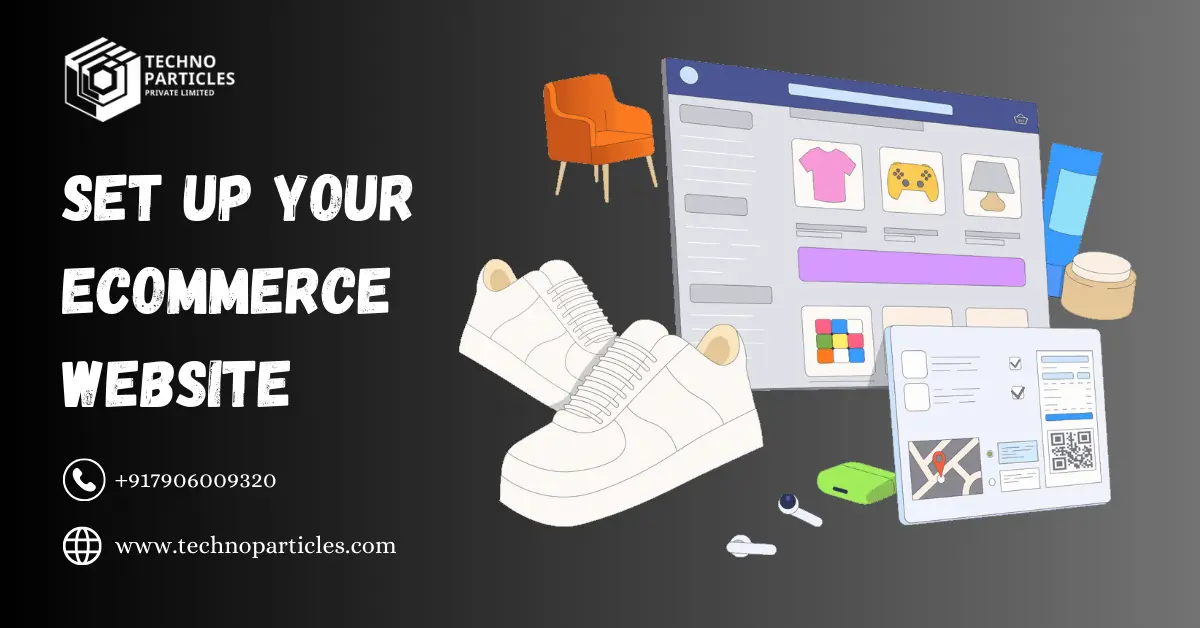Starting an eCommerce business can be incredibly exciting, offering limitless potential for growth, flexibility, and income.
Yet, for many newcomers, the journey from idea to profit can be confusing and challenging. With so many choices and strategies available, it’s easy to feel overwhelmed and uncertain about where to begin or which steps are essential for success.
But here’s the good news—building a thriving eCommerce business is completely within reach! In this guide, we’ll walk you through 7 critical steps designed to simplify the process, maximize your efforts, and set you on the path to success. Follow these steps, and you’ll be ready to create a profitable, sustainable eCommerce business from scratch.introduction
In today's digital era, starting an eCommerce business has become one of the most attractive options for entrepreneurs. With the rise of online shopping and digital payment solutions, more consumers are turning to the internet for convenience, variety, and competitive pricing. An eCommerce business allows you to reach a broader audience, operate with lower overhead costs, and scale your business more flexibly than traditional brick-and-mortar stores.
Why Start an eCommerce Business
Starting an eCommerce business comes with numerous benefits. Firstly, it provides flexibility—you can operate from anywhere, target different markets, and even experiment with various product niches. Secondly, eCommerce often requires a lower initial investment compared to physical stores, as there’s no need for rent, utilities, or high in-store staff costs. Additionally, eCommerce businesses can leverage data analytics to better understand their customers, leading to more effective marketing and higher customer satisfaction.
The Potential of eCommerce in Today’s Market
The global eCommerce market is experiencing unprecedented growth. Consumers worldwide are increasingly comfortable with online shopping, especially with advancements in secure payment gateways and mobile-friendly shopping experiences. Furthermore, as internet penetration and smartphone usage rise, even in remote areas, the potential to tap into previously inaccessible markets has expanded.
Step 1: Identify Your Niche
Choosing the right niche is the foundation of a successful eCommerce business. A niche allows you to target a specific audience with tailored products, marketing strategies, and branding. Identifying a profitable and sustainable niche can help you stand out in the competitive eCommerce market, ensuring you attract and retain customers who are genuinely interested in your offerings.
Understanding Market Needs
The first step in identifying your niche is understanding what the market needs. Start by analyzing current market trends, consumer behavior, and emerging demands. Tools like Google Trends, social media platforms, and industry reports can provide insights into what consumers are actively looking for. Think about specific pain points or desires that your products can address. By focusing on unmet needs, you can offer solutions that stand out and fulfill customer demands.
Researching and Validating Your Niche
Once you have an idea of a potential niche, it’s essential to research and validate it to ensure it’s a viable market. Look into your competitors to see who else is serving this niche and evaluate their strengths and weaknesses. Analyzing competitor reviews, forums, and social media can reveal areas where your business can add value or differentiate itself.
Next, validate your niche by checking the demand for products in your chosen area. Keyword research tools can help you gauge search volume and interest in specific products. Additionally, consider testing your niche through small-scale campaigns or surveys to gather direct feedback from potential customers.
Step 2: Product Market Research
Market research is a critical step in establishing a strong foundation for your eCommerce business. By understanding your competitors and defining your target audience, you can better position your products and develop strategies that appeal directly to your ideal customers.
Analyzing Competitors
Competitor analysis is essential for identifying opportunities and understanding where you can excel. Start by identifying your primary competitors within your niche. Look at their websites, product offerings, pricing strategies, and customer reviews. Pay close attention to their strengths and weaknesses—do they have exceptional customer service, a unique product line, or an effective social media presence? Or are there gaps in their offerings, like poor product quality or limited shipping options?
Use tools like SEMrush or Ahrefs to analyze your competitors' online presence, keywords, and traffic sources. This can give you insight into their marketing strategies and highlight potential keywords or content opportunities for your business. By knowing what competitors are doing well (and not so well), you can create strategies that help your business stand out.
Defining Your Target Audience
Defining your target audience is crucial for effective marketing and product development. Start by creating customer personas—fictional representations of your ideal customers that include details like age, gender, location, interests, buying behaviors, and pain points. Consider what motivates them to purchase, what they value most, and where they spend their time online.
Gather data through surveys, social media insights, or analytics tools to understand the demographics and psychographics of your audience. For example, if your audience consists mainly of young professionals, they might prefer convenient, mobile-friendly shopping experiences. Tailor your marketing messages, product selection, and overall brand tone to resonate with this audience. Understanding your target customers helps you to craft more targeted marketing strategies, ultimately leading to higher engagement and conversions.
Step 3: Choose a Business Model
Choosing the right business model is essential for the success of your eCommerce business. Your model determines how you’ll source, manage, and deliver products to customers. The main eCommerce models include dropshipping, manufacturing, and wholesale—each with unique advantages and challenges. Understanding which model aligns with your goals, budget, and logistics capacity will help set you on the right path.
Dropshipping
Dropshipping is a low-risk model where you don’t hold any inventory. Instead, when a customer places an order, you purchase the product from a third-party supplier who ships it directly to the customer. This model requires minimal upfront investment, making it ideal for beginners or those looking to test different products. However, dropshipping typically offers lower profit margins and limited control over product quality and shipping times, so it’s essential to carefully vet suppliers.
Manufacturing
The manufacturing model involves creating unique products, either by making them yourself or working with a manufacturer. This model is well-suited for businesses that want to offer exclusive or custom-designed products that differentiate them from competitors. While manufacturing allows for higher profit margins and brand control, it usually requires a significant upfront investment for production, storage, and quality control. This model is ideal if you have a unique product idea and a clear demand for it.
Wholesale
In the wholesale model, you buy products in bulk from manufacturers or distributors at a discounted rate, store the inventory, and sell it directly to customers at a markup. Wholesale provides more control over inventory and product quality compared to dropshipping, while also offering the potential for higher profit margins. However, it requires more capital and storage space to manage inventory, making it a better choice for those with an established customer base and steady demand.
Selecting the Right Model for Your Goals
Choosing the best business model depends on your resources, risk tolerance, and long-term goals. If you’re looking to minimize risk and upfront costs, dropshipping is a flexible and low-commitment option. For those who aim to create a unique brand and have the funds to invest, manufacturing offers greater control and differentiation. Finally, wholesale is an excellent choice if you have the capital and want to maintain inventory control while selling popular products with established demand.
Evaluating these options based on your business goals will help you choose the model that best suits your vision for success.
Step 4: Build Your Brand Identity
A strong brand identity is key to creating a memorable eCommerce business that resonates with your target audience. Your brand goes beyond just a name or logo—it's the personality, values, and message your business communicates. By crafting a unique brand identity, you can build a loyal customer base and stand out in a crowded market.
Crafting a Memorable Brand Name and Logo
Your brand name and logo are often the first things people notice about your business, so they should be memorable and reflective of what your brand represents. Start by brainstorming names that are unique, easy to pronounce, and relevant to your niche. Consider using keywords that hint at your products or values but avoid overly generic names that can get lost among competitors. Make sure the name is available as a domain for your website and across social media platforms.
Once you’ve chosen a name, work on creating a logo that visually captures your brand’s essence. Your logo should be simple yet impactful, with colors and shapes that align with your brand's personality. For example, a wellness brand might use calming colors like green or blue, while a tech brand might opt for sleek, modern fonts and shapes. Consider working with a graphic designer or using design tools like Canva or Adobe Illustrator to create a professional-looking logo.
Designing a Brand Voice and Image that Connects
Your brand voice and image are how you communicate with your audience across all platforms. Start by defining your brand’s core values, mission, and the emotions you want to evoke in customers. For instance, if your brand is playful and youthful, use friendly, informal language and vibrant colors. If it’s a high-end, luxury brand, opt for a more refined and elegant tone.
Think about your target audience and how they speak or what they relate to. Develop a consistent style for your messaging—whether it’s witty and conversational, informative and trustworthy, or adventurous and bold. This brand voice should be reflected in all your communications, from product descriptions and social media posts to email marketing.
Visual consistency is equally important. Choose a color palette, fonts, and imagery style that align with your brand’s personality and use them consistently. By maintaining a cohesive brand voice and image, you can create a memorable and authentic experience that builds trust and loyalty with your audience.
Step 5: Set Up Your eCommerce Website
Your website is the core of your eCommerce business—it’s where customers browse, learn about your brand, and make purchases. Setting up a user-friendly, professional website is essential for building credibility and maximizing conversions. Choosing the right platform and implementing key design elements will help you create a smooth shopping experience for your customers.
Choosing the Right eCommerce Platform
Choosing an eCommerce platform that fits your business needs and budget is one of the first decisions you’ll make when building your website. Popular platforms like Shopify, WooCommerce, and BigCommerce offer a range of features, from inventory management to customizable storefronts.
Shopify: Known for its ease of use, Shopify is ideal for beginners who want a simple, all-in-one solution. It includes tools for managing products, payments, and shipping, along with various customizable themes.
WooCommerce: As a WordPress plugin, WooCommerce is perfect for those who already use WordPress or want more control over their website’s customization. It’s open-source and highly flexible, though it may require more technical knowledge.
BigCommerce: Suitable for scaling businesses, BigCommerce offers advanced features for managing larger inventories and includes built-in SEO tools. It’s a robust platform with flexible customization options, making it ideal for more established businesses.
Each platform has unique benefits, so consider factors like budget, technical expertise, scalability, and the features you need for managing your products and customers.
Key Elements of a User-Friendly and Professional Website
Creating a professional, user-friendly website involves more than just choosing the right platform. Here are some essential elements that will enhance your site’s usability and make it visually appealing to customers:
Simple Navigation: Ensure your site is easy to navigate, with clear menus and category labels. A simple, intuitive navigation structure allows customers to find products quickly, improving the user experience and reducing bounce rates.
High-Quality Product Images and Descriptions: Use high-quality images from multiple angles to give customers a clear view of the products. Write compelling, informative descriptions that highlight the benefits, features, and unique aspects of each product.
Mobile Optimization: With a large portion of eCommerce traffic coming from mobile devices, your website should be fully optimized for mobile users. A responsive design ensures your site looks and functions well on screens of all sizes, enhancing the shopping experience on smartphones and tablets.
Fast Loading Speed: Slow-loading websites drive customers away, so optimize images, reduce unnecessary plugins, and use reliable hosting to improve your site speed. A fast-loading site not only enhances user experience but also positively impacts SEO rankings.
Secure Payment Options: Build trust by offering secure, reliable payment options such as credit cards, PayPal, or digital wallets like Apple Pay. Displaying security badges can reassure customers about the safety of their transactions on your site.
Clear Call-to-Action (CTA) Buttons: Guide visitors toward purchases with clear, visually prominent CTAs, such as “Add to Cart,” “Buy Now,” and “Checkout.” These buttons should stand out in color and placement to make the checkout process straightforward.
Customer Support Access: Include options for customer support, such as live chat, an FAQ page, or a contact form. Providing accessible support options builds trust and ensures customers can get help with questions or issues.
By setting up a well-designed website with these essential elements, you’ll create a shopping experience that’s enjoyable, trustworthy, and easy to navigate, encouraging customers to return to your store.
Step 6: Develop a Marketing Strategy
A well-rounded marketing strategy is essential to attract visitors to your eCommerce website, convert them into customers, and retain their loyalty. By leveraging social media, content marketing, SEO, email marketing, and paid ads, you can build a strong online presence and effectively reach your target audience.
Leveraging Social Media and Content Marketin
Social media and content marketing allow you to connect with your audience, showcase your products, and build brand loyalty. Choose platforms that align with your target audience, such as Instagram for a younger, visually-driven demographic or LinkedIn for a professional audience.
Social Media: Use social media to share engaging content, including product photos, tutorials, user-generated content, and behind-the-scenes glimpses. Host giveaways, collaborate with influencers, and use hashtags to increase your reach. Stories and live videos are effective tools for engaging with followers in real time and showcasing your brand’s personality.
Content Marketing: Content marketing helps educate, entertain, or inspire your audience. Create blog posts, videos, guides, or infographics that address your customers’ needs and questions. For example, a fashion brand might post styling tips, while a skincare brand could share routines for different skin types. This positions your brand as a helpful resource and builds trust with your audience.
SEO, Email Marketing, and Paid Ads
These strategies focus on driving targeted traffic, nurturing leads, and increasing conversions on your website.
SEO (Search Engine Optimization): Optimizing your website for search engines improves its visibility, helping potential customers find you through organic searches. Focus on keyword research to identify relevant search terms your audience uses. Optimize product pages, blog posts, and meta descriptions with these keywords. Building backlinks and maintaining a mobile-friendly, fast-loading site also boost your SEO rankings, leading to higher organic traffic over time.
Email Marketing: Email marketing is one of the most effective ways to nurture relationships with customers. Segment your email list to send personalized content to different customer groups, such as new subscribers, repeat customers, or inactive users. Send welcome emails, product recommendations, exclusive discounts, and post-purchase follow-ups. A well-designed email marketing strategy helps boost customer retention and can lead to increased sales.
Paid Ads: Paid advertising allows you to reach a wider audience quickly. Platforms like Google Ads, Facebook, and Instagram offer powerful ad tools to target users based on demographics, interests, and online behavior. Start with retargeting ads to reach people who have visited your site but didn’t make a purchase. Run seasonal campaigns or product-specific ads to attract new customers. Track your ad performance and adjust based on ROI to ensure your budget is being used effectively.
By integrating these strategies, you create a robust marketing approach that drives traffic, builds engagement, and boosts sales. A balanced strategy not only attracts new customers but also nurtures existing ones, fostering long-term growth and loyalty.
Step 7: Launch, Analyze, and Optimize
The final step in building a successful eCommerce business is to launch your store, closely monitor its performance, and continuously optimize for growth. Launching with impact can help you gain traction from the start, and regular analysis allows you to adapt strategies based on data, ensuring sustainable growth over time.
Launching Your Store with Impact
A successful launch involves more than just going live; it’s about creating excitement and driving initial traffic to your website. Here’s how to maximize your launch:
Build Pre-Launch Hype: Start promoting your store before it goes live. Share teasers on social media, build an email list, and offer sneak peeks or exclusive pre-launch discounts to your audience. This helps create anticipation and ensures you have potential customers ready to visit on launch day.
Offer Limited-Time Promotions: Launch with special offers such as discounts, free shipping, or a giveaway. Limited-time promotions can incentivize first-time purchases and generate a sense of urgency. Encourage customers to share their purchases on social media to extend your reach.
Engage Influencers and Partners: Partner with influencers or other brands in your niche to spread the word about your launch. Influencers can provide credibility and introduce your brand to a broader audience. Choose partners whose followers align with your target audience for maximum impact.
Analyzing Performance and Adjusting for Growth
Once your store is live, continuous analysis and optimization are key to growth. Tracking and interpreting data helps you understand what’s working and identify areas for improvement.
Track Key Metrics: Use tools like Google Analytics, Shopify Analytics, or similar platforms to monitor metrics such as website traffic, bounce rate, average order value, and conversion rate. Pay attention to sales trends, popular products, and high-traffic sources to understand which marketing efforts are yielding results.
Optimize Based on Data: Identify pages or products with low conversion rates, and consider changes such as improving product descriptions, adding customer reviews, or testing new images. Use A/B testing to experiment with different versions of landing pages, call-to-action buttons, or ad copy to see what resonates best with your audience.
Gather Customer Feedback: Customer feedback is invaluable for spotting potential improvements. Send post-purchase surveys or encourage reviews to learn more about the shopping experience. Feedback can reveal pain points or new opportunities to improve customer satisfaction.
Adapt Your Marketing Strategy: Evaluate the performance of each marketing channel, including social media, email, and paid ads. For example, if certain social media platforms or ad campaigns drive more traffic and conversions, consider allocating more budget and effort to those channels.
Scaling for Growth
Once you’ve optimized and built a loyal customer base, consider strategies for scaling your business. This might include expanding your product range, entering new markets, or increasing your ad spend. Scaling should be a gradual process based on data-driven insights, ensuring that your growth is sustainable and aligned with customer demand.
By launching with a strong plan, continuously analyzing performance, and adapting based on results, you can grow your eCommerce business into a successful and resilient brand.







Leave a comment